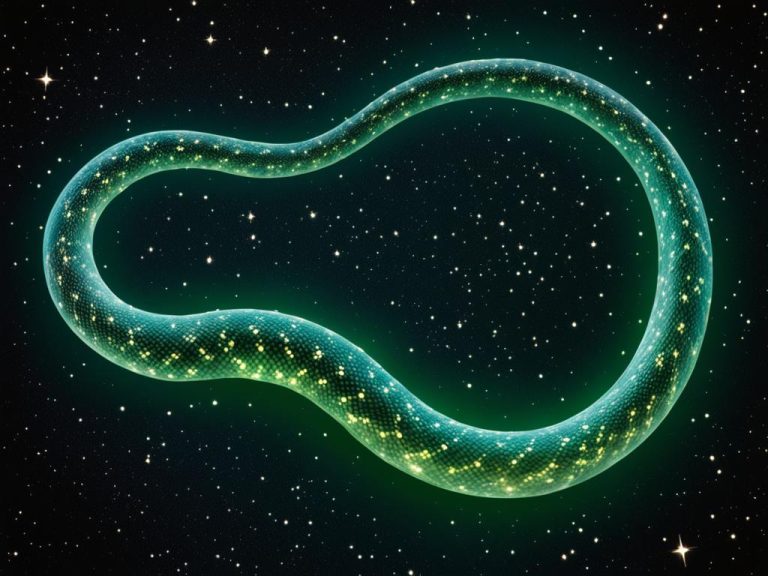Explore the Wonders of Serpens Cauda Constellation
Do you know the Serpens Cauda constellation? It is full of amazing sights in the night sky. This part of Serpens is in the northern hemisphere, next to Ophiuchus, Aquila, and Sagittarius. Serpens Cauda is important in history, myths, and astrology.
For centuries, Serpens Cauda has caught the eye of many. This constellation was linked to stories of healing in Greek myths and fertility in Babylonian tales. It has always been seen as a symbol of new beginnings and life.
In the sky, Serpens Cauda is a real treat. It has bright stars and deep sky wonders. Every stargazer, from new ones to experts, will love exploring this part of the universe. It shows us how vast and beautiful the night sky really is.
In astrology, Serpens Cauda’s stars are thought to impact our lives. They can affect who we are and how we get along with others. Many believe in the power of these stars to shape our destinies.
Are you excited to learn more about Serpens Cauda? We will look at its stories, what you can see, and how to see it from Ireland. Get ready to learn about the mysteries of our galaxy. This journey will make you see the stars in a whole new light.

Key Takeaways:
- 1. Serpens Cauda is a captivating constellation located in the northern hemisphere.
- 2. It has a rich history and mythology, associated with healing and fertility gods.
- 3. Serpens Cauda offers a visual feast for stargazers with its shimmering stars and deep sky objects.
- 4. The constellation holds astrological significance in interpreting personality traits and compatibility.
- 5. Explore the wonders of Serpens Cauda by delving into its history, mythology, and astronomical features.
The History and Mythology of Serpens Cauda Constellation
Known as the Serpent’s Tail, Serpens Cauda has fascinated people for ages. Its rich history and myths make it a starry wonder.
In Greek myths, it’s tied to Asclepius, a demigod who could raise the dead. His story adds mystery and awe to the constellation.
But, it’s not just Greek tales that shine through in Serpens Cauda’s story. The Babylonians saw it as part of their god Ningishzida’s image. This god was a protector. This link shows the wide influence and cultural reach of Serpens Cauda.
The constellation has been seen differently by many cultures. They all added their own tales to explain its glowing patterns. These stories give us a peek into ancient views of the stars.
Stargazing and Naming Your Own Star in Serpens Cauda Constellation
Looking at the stars in Serpens Cauda can be truly amazing. It is famous for its pretty look, a top pick for people who love space. Are you thinking of a cool gift? How about naming a star in Serpens Cauda for someone special?
International Star Registry helps you name a star in Serpens Cauda. You can do it on their site, starregistry.com. There, you’ll find different naming packages. Pick a star that means a lot to either you or the person you’re giving it to.
Naming a star is a very heartfelt thing to do. It shows someone you love them a lot, maybe on a birthday or anniversary. You get a special certificate and a map to show where the star is in the sky. International Star Registry makes sure your star is one of a kind and puts it in their official record.
The Astronomical Features of Serpens Cauda Constellation
Serpens Cauda is known as the tail of the Serpent constellation. It shines with amazing features and deep sky objects. Even though it doesn’t have many bright stars, it is full of cosmic beauty.
The Eagle Nebula, also called Messier 16, is a top feature. This open cluster is in a cloud of gas and dust that looks amazing. The Hubble Space Telescope found the famous “Pillars of Creation” here, showing new stars being born.
The Omega Nebula, or Messier 17, is another special site. It’s a large cloud of gas that’s making new stars right now. This process, seen as a red glow, is a big part of the constellation’s beauty.
The Red Square Nebula is unique in Serpens Cauda. It’s a planetary nebula showing a dying star’s remains. The Red Square Nebula’s shape is quite special and draws a lot of interest.

Exploring Serpens Cauda is truly fascinating. From the Eagle Nebula to the Red Square Nebula, it shows the beauty of our universe.
Viewing Serpens Cauda Constellation from Ireland
Serpens Cauda is a stunning constellation in the night sky. It can be seen in Ireland. Here’s how you can see it.
Timing Is Everything
Summer is the best time to see Serpens Cauda in Ireland. The nights are clear then. This lets you see it better without the sky’s moisture affecting it. So, visit Ireland from June to August for the best view.
Locating Serpens Cauda
Serpens Cauda is one half of the Serpens constellation, with its counterpart being Serpens Caput, the Serpent’s Head. Together, they form a winding serpent slithering through the heavens. Located in the northern hemisphere, Serpens Cauda is bordered by the constellations of Ophiuchus, Aquila, and Sagittarius.It’s east of a bright star called Vega in Lyra. Go where there’s less light pollution to see it clearly. Choose the countryside or a remote spot to avoid city lights.
A star chart or a mobile app can make finding it easy. These tools act like a map of the sky. They help you spot the constellation.
Look up at Serpens Cauda and let its beauty amaze you. Its stars form a beautiful shape. This makes you feel small but connected to the vast universe.
Remember to bring something to sit on when you go stargazing in Ireland. This lets you relax under the stars. Being in the quiet countryside enhances your experience.
If you’re in Ireland, don’t miss Serpens Cauda. Look up during summer nights. You’ll see a spectacular part of the night sky and feel part of the cosmos.
The Mythology of Serpens Cauda Constellation
The mythology tied to Serpens Cauda is fascinating. In Greek tales, it’s linked to Hercules and Apollo. These legends make Serpens Cauda’s stars even more wondrous.
Serpens Cauda is involved in a story about Hercules vs. a snake. Hera sent the snake to kill Hercules, but he won. This myth shows that good can always beat bad. It highlights Serpens Cauda’s role in celebrating victory.
Another story connects Serpens Cauda to Apollo, the sun god. He sent a crow to get a snake, but the bird got distracted. Angry, Apollo turned the crow black and the water snake into Serpens Cauda. This story reflects Greek myths’ themes of punishment and learning from mistakes.
The Serpens Cauda constellation stands for these ancient stories of bravery and lessons. It keeps alive the myths that have fascinated people for ages.
Learning about a constellation’s stories opens our eyes to the universe. Each constellation shares a different tale, drawing us into human dreams and the unknown of space.
Notable Stars in Serpens Cauda Constellation
In the beautiful Serpens Cauda, many stars are loved by astronomers and lovers of the sky. Alpha Serpentis, or Unukalhai, shines with a special orange light. It’s one of the brightest, making it easy to spot.
Beta Serpentis, known as Chow, is a stunning yellow giant. Its glow adds to the beauty of Serpens Cauda. With Alpha Serpentis, they make the constellation even more special.
If the universe intrigues you, look closely at Serpens Cauda’s stars. Their brightness and features make this constellation stand out. It’s a place worth exploring and finding joy in.
Do you want to know more about Serpens Cauda and its celestial wonders? Go to the Wikipedia page on Serpens. Or visit Constellation Guide’s article on Serpens. You can also see more at Go Astronomy’s Serpens page.
Deep Sky Objects in Serpens Cauda Constellation
The Serpens Cauda constellation has many amazing deep sky objects. These catch the eye of both scientists and people who love looking at the stars. One special object is Messier 5, a large group of stars, about 24,500 light-years from us.
Messier 5 has hundreds of thousands of stars close together. It is very old, around 13 billion years. Its brightness and its place in Serpens Cauda make it great for scientists to study.
Another fascinating object in Serpens Cauda is the Eagle Nebula. This area where new stars are born is known for its Pillars of Creation. These huge columns of gas and dust are where stars are made, showing a beautiful and magical side of space.
The Omega Nebula, also called the Swan Nebula or Messier 17, is a bright part of the constellation. It gets its light from young stars. Its shape looks like the Greek letter “Omega,” making it stand out.
Studying the deep sky of Serpens Cauda shows us how beautiful and vast space is. From Messier 5, to the Eagle Nebula, to the Omega Nebula, there’s so much awe-inspiring scenery in this part of the universe.
The Celebrities and Serpens Cauda Constellation
Serpens Cauda has caught the eye of many stars. Famous people like Ozzy Osbourne, and Kevin Bacon, have their star in this breathtaking constellation.
Stars like these make Serpens Cauda even more fascinating. They show how people from all walks of life are drawn to the stars.
Naming a star in Serpens Cauda is a special gift idea. It’s great for any time you want to show someone you care. By naming a star through International Star Registry, you make it official. The name you pick will be in their records forever. This lets you mark important moments, celebrate people you love, or just show your love for space.
Are you a fan of Ozzy Osbourne? Or do you just want a unique link to the night sky? Naming a star in Serpens Cauda Constellation is a charming and unforgettable way to make your own space in the galaxy.
Naming a Star in Serpens Cauda Constellation
Imagine having your own piece of the cosmos, a star shining brightly in the vast expanse of Serpens Cauda. With International Star Registry, you can make this dream a reality. Whether it’s for a birthday, Christmas, or anniversary, naming a star in Serpens Cauda is a unique and unforgettable gift.
By visiting starregistry.com, you can explore the various star-naming packages available. Choose the star you wish to name, personalize your star certificate, and receive a stunning star chart to locate your celestial treasure in the night sky. It’s a timeless gesture that will leave a lasting impression on your loved ones.
Dive into the amazing world of Serpens Cauda by naming a star there. International Star Registry lets you make a special connection with the cosmos. You can mark a unique moment or honor someone special.
Name a star after someone with International Star Registry for the perfect gift. It’s great for birthdays, anniversaries, or to show love. This gesture makes for a meaningful and lasting symbol of affection.
When you name a star, you get a special certificate and star chart. They show your star’s exact place in Serpens Cauda. This package is a true symbol of your bond with the universe and your loved ones.

Naming a star in Serpens Cauda adds to our love for the night sky. It’s a wonderful experience for anyone who loves stars or finds joy in our universe.
Choosing International Star Registry means a genuine and memorable star-naming experience. Since 1979, they have helped people make their mark in the stars.
Don’t wait any longer. Join the celestial wonder when you buy a star for someone in Serpens Cauda through International Star Registry. Your star will always shine, celebrating your special bond.
Conclusion
Serpens Cauda is one half of the Serpens constellation. It is a favorite of astronomers and stargazers. This constellation sits in the northern hemisphere, between Ophiuchus, Aquila, and Sagittarius. Serpens Cauda is full of history and myths from all over the world.
According to Greek myths, Serpens Cauda is connected to Asclepius, a healing demigod. The Babylonians saw it as the god Ningishzida, linked to fertility, healing, and the underworld. These ancient stories make the constellation even more interesting.
Visit starregistry.com and make a connection to the universe. It’s a unique way to show love, remember someone, or celebrate a big moment with an unforgettable gift.
FAQ
What is Serpens Cauda Constellation?
Serpens Cauda is a fascinating part of the night sky. It’s known as the tail of the Serpens constellation, with Serpens Caput as the head.
Does Serpens Cauda have any astrological significance?
Yes, it’s very significant in astrology. Its beauty and features stand out.
What is the history and mythology behind Serpens Cauda Constellation?
Serpens Cauda’s history and myths go back many centuries. In Greek tales, it’s tied to Asclepius, a healing demigod, and his snake helper. It’s also connected to Ningishzida, a Babylonian god seen as a protector.
Can I name a star in the Serpens Cauda Constellation?
You can name a star through International Star Registry. They provide personalized certificates and star charts, making it a unique gift.
What are some notable deep sky objects in Serpens Cauda?
In Serpens Cauda, you’ll find the Eagle Nebula, the Omega Nebula, and the Red Spider Nebula.
Can Serpens Cauda be viewed from Ireland?
Yes, it can be seen in Ireland. Knowing when and where to look is key. The best time to see it is during summer when it’s high in the sky.
What is the mythology associated with Serpens Cauda?
Greek myths tell of Hercules and Apollo’s ties to Serpens Cauda. It includes a story where a snake was sent to kill Hercules but failed.
Are there any notable stars in the Serpens Cauda Constellation?
Yes, Alpha Serpentis (Unukalhai) and Beta Serpentis (Chow) are notable stars in Serpens Cauda.
What are some deep sky objects in the Serpens Cauda Constellation?
It has Messier 5, the Eagle Nebula, and the Omega Nebula among its deep sky objects.
Which celebrities have stars in the Serpens Cauda Constellation?
Celebrities like Ozzy Osbourne, Kevin Bacon, and Ethan Embry have stars there.
How can I name a star in Serpens Cauda?
Visit starregistry.com to name a star. International Star Registry offers certificates and star charts for your unique star.
Source Links
- Serpens Constellation: A Guide to Viewing from Ireland – https://stargazingireland.com/serpens-constellation-a-guide-to-viewing-from-ireland/
- Serpens – https://www.starregistry.com/constellation-name/serpens/
